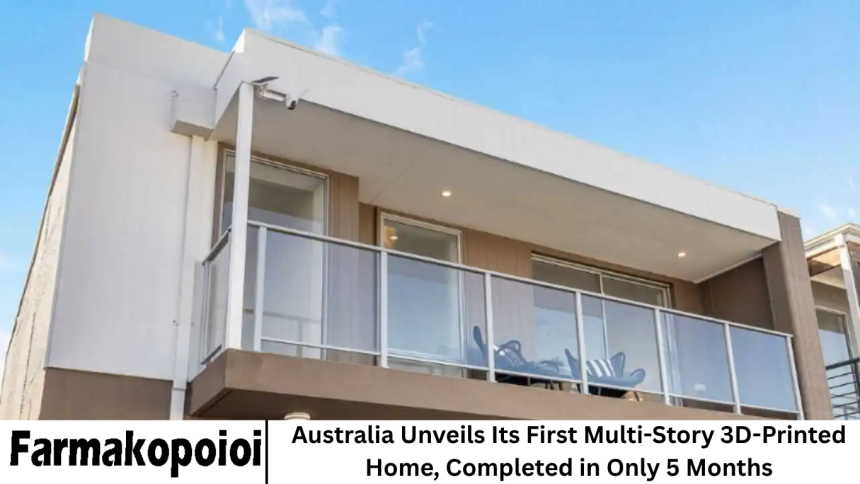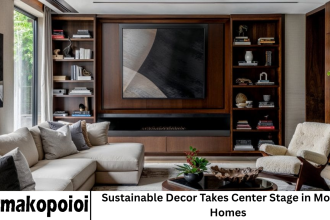Australia has officially entered a new era of innovation with the unveiling of its first multi-story 3D-printed home, completed in just five months. This remarkable achievement signifies more than just architectural progress—it represents a technological revolution in how homes are built, designed, and delivered.
- The Rise of 3D Printing in Construction
- The Vision Behind the Project
- The Technology: How It Was Built
- Digital Design
- Printing the Structure
- Assembling the Floors and Roof
- Interior Finishing and Smart Features
- Sustainability at Its Core
- Addressing Australia’s Housing Challenges
- A Symbol of Innovation and Future Potential
- The Human Touch: Combining Technology and Craftsmanship
- Economic and Industry Impact
- Global Context: 3D Printing Homes Around the World
- The Future of 3D-Printed Architecture in Australia
- Frequently Asked Question
- Conclusion
Using advanced concrete printing systems and cutting-edge robotics, the project showcases how 3D printing can solve major challenges in affordability, sustainability, and housing demand. Developed by a collaboration between construction engineers, architects.
This article explores the full story behind this innovation: how it was built, what technologies were used, what it means for the housing market, and how it could reshape the construction industry in Australia and beyond.
More Read: Supreme Court’s New Term to Center on Expanding Battles Over Executive Power
The Rise of 3D Printing in Construction
3D printing—also known as additive manufacturing—has been steadily transforming multiple industries, from healthcare to automotive design. But in recent years, it has become a game-changer in construction.
The concept involves using large-scale printers that deposit materials, layer by layer, to create structures directly from digital blueprints. Unlike traditional methods that require extensive manual labor, 3D printing allows builders to automate most of the process.
The benefits are staggering: reduced waste, faster build times, lower costs, and increased customization. Until recently, most 3D-printed buildings were single-story prototypes, often designed to test the limits of the technology.
However, Australia’s new multi-story home has broken through that limitation, proving that even complex architectural designs can be constructed using 3D printing on a large scale.
The Vision Behind the Project
The project was spearheaded by a partnership between Luyten 3D, an Australian construction technology firm, and a consortium of local developers and universities. Their shared goal was clear: to demonstrate that 3D printing could produce a durable, energy-efficient.
And cost-effective home suitable for Australia’s diverse climate conditions. The team envisioned a home that combined modern sustainability goals with rapid construction techniques. With housing affordability becoming a pressing issue across the country.
This innovation aimed to prove that high-quality housing could be built faster and more efficiently—without sacrificing aesthetics or safety. The project began in early 2025 with site preparation and digital modeling.
Within five months, the structure was completed—making it the fastest-built multi-story home in Australia.
The Technology: How It Was Built
At the heart of the project was an industrial-scale 3D concrete printer, developed to handle high-strength cementitious material. The printer worked from a digital 3D model, interpreting architectural blueprints to precisely lay layers of a specialized geopolymer concrete mix.
Digital Design
Architects created a detailed 3D model of the home using Building Information Modeling (BIM) software. This allowed for real-time simulations of load-bearing capabilities, thermal insulation, and energy performance. Every aspect—from walls to window openings—was digitally planned before printing began.
Printing the Structure
Once the model was finalized, the 3D printer began depositing concrete layer by layer. Unlike traditional bricklaying or framing, the printer could work continuously, creating walls with complex geometries and integrated insulation cavities.
The printer’s precision ensured minimal material waste. Advanced sensors monitored curing times and layer alignment to guarantee structural stability, even in the multi-level format.
Assembling the Floors and Roof
For the second story, the team used a hybrid approach—combining 3D-printed walls with prefabricated floor slabs and reinforced frameworks. This hybridization made it possible to achieve greater vertical strength while maintaining the design’s efficiency.
Interior Finishing and Smart Features
Once the shell was complete, electricians and plumbers installed wiring and fixtures through predesigned conduits printed into the walls. The home was also equipped with smart energy systems, including solar panels, rainwater harvesting, and automated lighting.
The result was a two-story, 3-bedroom residence that not only met but exceeded Australian building standards.
Sustainability at Its Core
One of the most striking aspects of this project is its environmental sustainability. The 3D printing process consumes up to 60% less material waste compared to traditional construction. The geopolymer concrete mix used also emits less carbon dioxide than conventional Portland cement.
Moreover, because 3D printing relies on digital precision rather than manual error, every layer is optimized for thermal and structural performance. The design naturally incorporates energy-efficient features like cross-ventilation, double insulation, and passive solar heating.
The reduced need for transportation and heavy machinery also contributes to a smaller carbon footprint. The printer can be assembled on-site, eliminating the need to transport large quantities of pre-made materials.
This aligns with Australia’s broader climate commitments and sustainable housing goals for 2030, setting a precedent for eco-friendly building practices.
Addressing Australia’s Housing Challenges
Australia is currently facing one of its most significant housing shortages in decades. Rapid population growth, rising material costs, and labor shortages have driven up housing prices nationwide.
3D printing technology could provide a practical solution to these challenges. By drastically reducing construction times and cutting costs, it could make homeownership more accessible to average Australians.
A typical home built using traditional methods can take nine to twelve months or longer, depending on weather conditions and labor availability. This 3D-printed home, however, was completed in just five months—a pace that could be further reduced as the technology matures.
If widely adopted, experts estimate that construction costs could drop by 20–40%, allowing for rapid development of affordable housing projects, especially in rural and remote areas.
A Symbol of Innovation and Future Potential
The success of Australia’s first multi-story 3D-printed home sends a powerful message: the country is ready to embrace next-generation construction methods. This achievement not only boosts national pride but also attracts global attention.
International developers are already studying the Australian model to replicate similar projects in Europe, North America, and Southeast Asia.
Local universities have also announced plans to launch research programs exploring materials science, robotics integration, and AI-driven construction planning—all inspired by this milestone.
In the long run, this breakthrough could lead to entire 3D-printed communities, smart cities, and disaster-resilient housing projects built within weeks instead of months.
Challenges and Limitations
Despite its groundbreaking nature, 3D-printed construction still faces several technical and regulatory challenges.
- Building Codes: Australia’s construction regulations are still evolving to include 3D-printed structures. Many local councils lack established frameworks for inspecting or approving such buildings.
- Material Durability: While geopolymer concrete is strong and eco-friendly, long-term data on its performance in multi-story buildings is limited.
- Skilled Labor Shortage: Operating industrial 3D printers requires specialized training. The construction industry must upskill workers to handle this technology efficiently.
- Public Perception: Many homeowners remain cautious about living in a 3D-printed house, questioning safety, durability, and insurance coverage.
However, experts believe these hurdles will gradually be overcome as more projects prove the reliability and cost-effectiveness of the technology.
The Human Touch: Combining Technology and Craftsmanship
While 3D printing automates much of the construction, human expertise remains essential. Architects, engineers, and technicians worked together to refine the design, monitor print quality, and complete the final finishes.
In this way, the project doesn’t eliminate human involvement—it elevates it. Skilled workers focus on design precision, energy systems, and interior aesthetics rather than repetitive labor. This combination of automation and creativity sets the stage for a hybrid construction future, where efficiency meets artistry.
Economic and Industry Impact
The construction industry contributes significantly to Australia’s economy, but it has long struggled with inefficiencies, delays, and high material costs. The introduction of 3D printing could streamline workflows and improve profitability across the board.
By reducing the dependency on imported materials and labor, Australia can build self-reliant housing ecosystems. This could also attract foreign investment in local tech infrastructure, robotics manufacturing, and material innovation.
According to early projections, if even 10% of new homes in Australia were 3D-printed by 2030, it could save billions of dollars annually in material costs and labor expenses.
Global Context: 3D Printing Homes Around the World
Australia’s breakthrough joins a growing global movement. Countries like the United States, Denmark, and the Netherlands have already built 3D-printed homes, though most remain single-story prototypes.
For example:
- In the U.S., companies like ICON have built affordable housing communities using 3D printing.
- In the Netherlands, the Project Milestone houses combine sustainable design with fully printed concrete walls.
- In the UAE, Dubai aims to have 25% of new buildings 3D-printed by 2030.
Australia’s multi-story home, however, stands out for combining vertical architecture, sustainability, and compliance with strict building standards—all within an impressively short construction period.
The Future of 3D-Printed Architecture in Australia
Looking forward, experts predict that 3D printing will soon become mainstream in Australian construction. The next step involves scaling the technology for multi-unit apartments, schools, and public buildings.
Government agencies are already exploring pilot programs to deploy 3D-printed housing in remote communities where construction materials and labor are scarce.
As printing materials diversify—from geopolymer concrete to recycled plastics and bio-based composites—the future of architecture will likely blend technology, ecology, and design innovation like never before.
Frequently Asked Question
What makes Australia’s 3D-printed home unique?
Australia’s first multi-story 3D-printed home is unique because it combines advanced construction robotics with sustainable geopolymer materials and a fully functional design. It’s also the first of its kind to meet national building standards while being completed in just five months.
How long did it take to build the home?
The entire project took only five months from design to completion—less than half the time required for traditional multi-story homes.
What materials were used in the construction?
The home was built using a geopolymer concrete mix, an eco-friendly alternative to standard cement. This material emits less carbon dioxide and provides excellent strength and thermal insulation.
How does 3D printing reduce construction costs?
3D printing automates most of the construction process, significantly reducing labor costs and material waste. The technology also allows for faster project completion, saving both time and money.
Is the home energy efficient?
Yes. The home incorporates several sustainable features, including natural ventilation, solar energy systems, rainwater harvesting, and insulated wall designs that improve energy efficiency.
Can 3D-printed homes withstand Australia’s weather conditions?
Absolutely. The structure has been engineered to withstand Australia’s varied climates, including high heat, heavy rain, and wind. The geopolymer concrete provides durability comparable to, or even greater than, conventional materials.
What’s next for 3D-printed housing in Australia?
Following this project’s success, more 3D-printed housing initiatives are planned across the country. Future developments will include affordable housing, emergency shelters, and eco-friendly residential communities.
Conclusion
The completion of Australia’s first multi-story 3D-printed home marks a turning point in construction history. What was once science fiction is now a tangible reality—proof that sustainable, affordable, and efficient housing can be achieved in record time.
By blending technology, sustainability, and creativity, this achievement redefines what’s possible in architecture. It opens the door to a future where entire communities could be 3D-printed—faster, greener, and smarter than ever before.






















